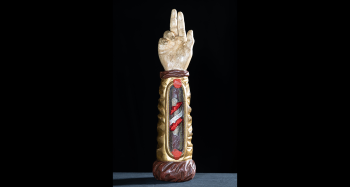Fr. Carlos Martins, a Custos Reliquiarum (ecclesiastically-appointed curate of relics) and Director of Treasures of the Church, will bring the arm of St. Jude Thaddeus to Holy Infancy Parish, Bethlehem, on November 7. Veneration will begin at 1 p.m. followed with a Mass in honor of St. Jude at 7 p.m.
The Vatican has made this important relic available for the first-time for a national tour in the U.S.
St. Jude Thaddeus is a New Testament saint and apostle who personally knew, walked with, and lived with Jesus himself. The Gospel of John records St. Jude as asking Jesus at the Last Supper, “Master, [then] what happened that you will reveal yourself to us and not to the world?” (John 14:22)
In the early Church, St. Jude was sometimes confused with Judas Iscariot, the apostle who betrayed Jesus, since their names are identical in Latin and Greek. This led to St. Jude becoming “the forgotten saint.” In Scriptures, he is also referred to as Thaddeus (Matthew 10:3 and Mark 3:18).
Tradition holds that, because his help was rarely invoked due to this unfortunate coincidence, St. Jude remains ready to answer the petitions of those who are desperate enough to call upon his aid.
Additionally, Our Lord encouraged St. Bridget of Sweden in a vision to trust in St. Jude, saying: “In accordance with his surname, ‘Thaddeus,’ the amiable, loving, he will show himself most willing to give help.”
Relics are physical objects that have a direct association with the saints or with Our Lord. We venerate relics because the bodies of saints are the living temples of the Holy Spirit.
The arm of St. Jude is considered a first-class relic because it is a bone fragment belonging to the Apostle’s body. Second-class relics are something that a saint personally owned, such as a garment. Third-class relics are items that a saint touched or that have been touched to a first or second-class relic of a saint.
Relics are introduced in the Second Book of Kings, when the body of a man comes back to life after touching the bones of the prophet Elisha (2 Kings 13:20-21). In Acts chapter 19, the sick are healed and freed from evil spirits by touching handkerchiefs that have been in contact with St. Paul.
When relics are mentioned in Scripture, two things occur: First, there is healing, and second, touch is the way by which the healing comes about. Relics are thus a means by which God Himself acts.
The Holy See has issued a plenary indulgence available to all pilgrims who venerate Saint Jude’s relics. A plenary indulgence is a special type of indulgence that, if all the requirements are met, erases a person’s time accrued in purgatory due to sin.
Anyone who would like to experience the help of St. Jude, the apostle who stands before the throne of God ready to intercede, is invited to attend.
For more information about the relic of St. Jude, visit www.apostleoftheimpossible.com.
Photo provided by Treasures of the Church.








